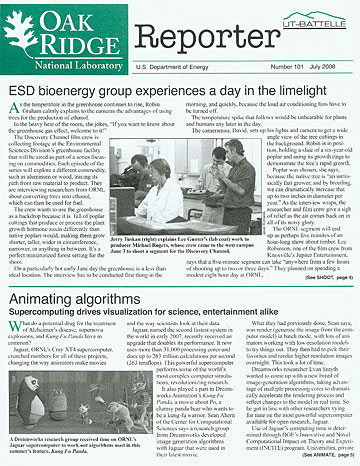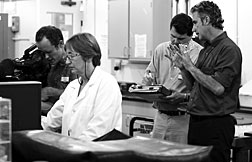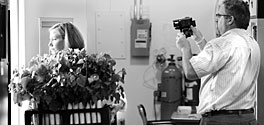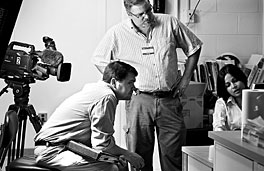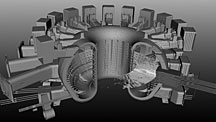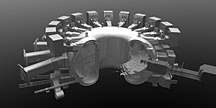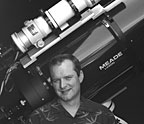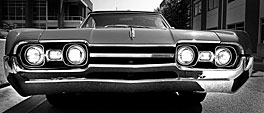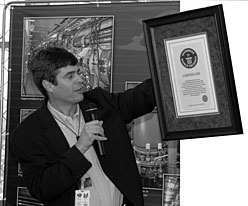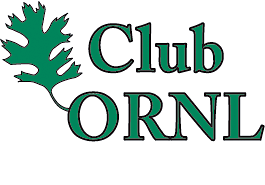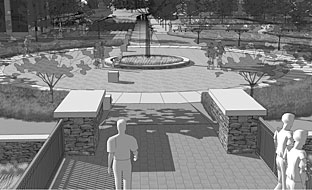 |
Number 101, July 2008 |
 ESD bioenergy group experiences a day in the limelight
ESD bioenergy group experiences a day in the limelight
|
|
Jerry Tuskan (right) explains Lee Gunter’s (lab coat) work to producer Michael Rogers, whose crew came to the west campus June 3 to shoot a segment for the Discovery Channel. |
As the temperature in the greenhouse continues to rise, Robin
Graham calmly explains to the cameras the advantages of using trees for the production of ethanol.
In the heavy heat of the room, she jokes, “If you want to know about the greenhouse gas effect, welcome to it!”
The Discovery Channel film crew is collecting footage at the Environmental Sciences Division’s greenhouse facility that will be aired as part of a series focusing on commodities. Each episode of the series will explore a different commodity, such as aluminum or wood, tracing its path from raw material to product. They are interviewing researchers from ORNL about converting trees into ethanol, which can then be used for fuel.
The crew wants to use the greenhouse as a backdrop because it is full of poplar cuttings that produce or process the plant growth hormone auxin differently than native poplars would, making them grow shorter, taller, wider in circumference, narrower, or anything in between. It’s a perfect miniaturized forest setting for the shoot.
On a particularly hot early June day the greenhouse is a less than ideal location. The interview has to be conducted first thing in the morning, and quickly, because the loud air conditioning fans have to be turned off.
The temperature spike that follows would be unbearable for plants and humans any later in the day.
The cameraman, David, sets up his lights and camera to get a wide angle view of the tree cuttings in the background. Robin is in position, holding a slice of a six-year-old poplar and using its growth rings to demonstrate the tree’s rapid growth.
Poplar was chosen, she says, because the native tree is “an intrinsically fast grower, and by breeding, we can dramatically increase that up to two inches in diameter per year.” As the interview wraps, the researcher and film crew give a sigh of relief as the air comes back on in all of its noisy glory.
|
Against a lab backdrop, interviewee Brian Davison waits for the camera to roll. |
The ORNL segment will end up as perhaps five minutes of an hour-long show about timber. Lee Robinson, one of the film crew from Knoxville’s Jupiter Entertainment, says that a five-minute segment can take “anywhere from a few hours of shooting up to two or three days.” They planned on spending a modest eight hour day at ORNL.
They spend much of that time with the Plant Genome group, interviewing several of the team members and using the greenhouse, growth chambers and lab as backdrops. Robin, leader of ESD’s Energy & Environmental Systems Science group and acting director of the Center for BioEnergy Sustainability, is just the first interview of the day.
Preferring a cooler locale, the crew moves inside the lab. Bioenergy center chief scientist Brian Davison talks about the starring role microorganisms play in the conversion of wood to fuel. Many of the lab members gather outside the doorway to watch the stage being set, complete with cool blue lights.
|
The Plant Systems Biology group’s Ashley Walker enters one of the greenhouse’s growth chambers, captured on tape. |
The fact that much of what is recorded will never be seen on TV doesn’t dampen the enthusiasm of the group. Ashley Walker, one of the spur-of-the-moment interviewees, says that it doesn’t matter if her part never appears on TV; “It’s still a once in a lifetime opportunity, to be able to say that the Discovery Channel came to film in your lab.”
The film crew is just as enthusiastic. Taking advantage of the colorful equipment inside the lab, they shoot quite a bit of B-roll, or noninterview footage of the general environment to be used to fill out the segment.
|
The Plant Systems Biology group’s Alina Campbell demonstrates work in the greenhouse, filmed by a counterweighted camera. |
They especially enjoy filming a root imaging system that lets the researchers determine the mass of a plant’s roots without harming the plant. Lab manager Lee Gunter makes sure that lab samples are not contaminated by using a “stunt double” instead of the real thing while the film crew surrounds her and her root samples with cameras and lights for a close-up view.
ORNL researcher Udaya Kalluri is most impressed when, at the very end of her interview, the film crew collects “room time,” a few seconds of silence in the room that they can subsequently use back in the studio to replace verbal stumbles, making even a plant scientist far removed from Hollywood “sound like a smooth talker.”
|
Producer Michael Rogers (left) listens as Plant Systems Biology group researcher Udaya Kalluri explains her work for a background interview. |
As the last interview of the day, Jerry Tuskan from ORNL’s Plant Genomics Group is no stranger to publicity. He is one of the researchers that sequenced the first tree genome, published in Science in 2006, news that made headlines and got him a live interview on NPR’s talk show Science Friday. But even Jerry finds the experience somewhat unique, saying, “They surround you with lights, cameras and mikes, and tell you to act natural!”
Jerry praises the groups for standing up to the stress of being surrounded by cameras, lights and general chaos for the day.
“Everyone did a great job. We’re really lucky; we have a great group that really works well together.”
Michael Rogers, the producer of the segment, says, “That was fantastic. If we can’t make five minutes out of that, we need to get another job.”—Sarah Wright ![]()
Sarah Wright is this summer’s Communications & External Relations intern from the University of Tennessee’s science writing program.
 Animating algorithms
Animating algorithms
Supercomputing drives visualization for science, entertainment alike

|
A Dreamworks research group received time on ORNL’s Jaguar supercomputer to work out algorithms used in this summer’s feature, Kung Fu Panda. |
What do a potential drug for the treatment of Alzheimer’s disease, supernova explosions, and Kung Fu Panda have in
common?
Jaguar, ORNL’s Cray XT4 supercomputer, crunched numbers for all of these projects, changing the way animators make movies and the way scientists look at their data.
Jaguar, named the second fastest system in the world in early 2007, recently received an upgrade that doubles its performance. It now uses more than 31,000 processing cores and does up to 263 trillion calculations per second (263 teraflops). This powerful supercomputer performs some of the world’s most complex computer simulations, revolutionizing research.
It also played a part in Dreamworks Animation’s Kung Fu Panda, a movie about Po, a clumsy panda bear who wants to be a kung-fu warrior. Sean Ahern of the Center for Computational Sciences says a research group from Dreamworks developed image generation algorithms with Jaguar that were used in their latest movie.
What they had previously done, Sean says, was render (generate the image from the computer model) in batch mode, with lots of animators working with low-resolution models to try things out. They then had to pick their favorites and render higher resolution images overnight. This took a lot of time.
Dreamworks researcher Evan Smyth wanted to come up with a new breed of image-generation algorithms, taking advantage of multiple processing cores to dramatically accelerate the rendering process and reflect changes to the model in real time. So he got in line with other researchers vying for time on the most powerful supercomputer available for open research, Jaguar.
Use of Jaguar’s computing time is determined through DOE’s Innovative and Novel Computational Impact on Theory and Experiment (INCITE) program. Universities, private industry and government research laboratories apply for computing time amounting to more than 100 million processor hours.
Scientists use visualization for increased understanding of data, and animators use it for entertainment. “Animators don’t do it to help you understand the science; they do it to tell the story,” Sean says, “but they drive realistic image generation.”
|
Images of the ITER fusion experiment using a simple (top) and more complex (bottom) ray tracing algorithm that calculates theoretical light interactions, increasing the rendering’s realism. |
Realism in image generation comes down to one thing—light. Getting the play of light right—its behavior as it reflects, refracts and diffuses—turns out to be the key factor in making a computer-generated image appear real.
The calculations involved in ray tracing, or tracing the theoretical path of light rays as they interact with the surfaces of the model, “make image generation incredibly computing intensive,” says Sean. Calculating millions of bounces for each ray of light, with different degrees of penetration, diffusion, reflection or refraction at every surface they encounter, can take days to compute, depending on the complexity of the environment being modeled.
To illustrate his point, Sean shows two movies he has made of the ITER fusion reactor, the international project to develop new sources of electrical power.
The movie shows radio frequency energy bouncing around in the reactor.
The first movie uses a simple lighting model that takes only a few minutes to render. The second movie uses a lighting model that adds reflections and shadows, increasing the rendering time to about two days. The added detail increases the reality, putting you inside the reactor while the energy is reflecting on the shiny metal walls.
Says Sean, “You can tell stories that you could not tell 20 years ago by making movies of processes that can’t be filmed.” This is good for scientists because “it provides more tools for conveying data to our human visual system, presenting it in a form that is more easily understood by the human brain.”
The Lab members at the Center for Computational Sciences have given several researchers their first glimpses of data from research projects they have put months or even years of effort into, and the images often flip a switch, helping the scientists draw new information from the data.
“They just didn’t get the whole picture until they saw the rendering,” says Sean.
Ed Uberbacher of the Biosciences Division benefited from the center’s help in visualizing his research project. Looking at his model of a new drug that could help to treat Alzheimer’s, he noticed that some small additions and changes in the chemical structure of the drug would increase its ability to interact with the proteins that form the Alzheimer’s-inducing plaques in the brain.
Sean also recalls the Physics Division’s Tony Mezzacappa also having an a-ha moment when he looked at the data visualization of a simulated supernova explosion.
He saw an asymmetry, a lop-sidedness to the rotation that was surprising. The data represented a possible explanation for instabilities in the shock waves formed during the core-collapse and subsequent explosion of massive stars.
The mechanism behind the explosion of a supernova is one of the most important unsolved problems in astrophysics and has been the subject of numerical simulations for more than three decades. The new information in Tony’s simulation was lurking in the numbers all along but was not understood until it was presented in visual format.
The goal is “to deliver images that someone can understand, to do it better, more easily and faster,” Sean says. “If I can do that, it means that we are reducing the time to understanding.”—Sarah Wright ![]()
 ORNL adds six to its all-time tally of R&D 100 Awards
ORNL adds six to its all-time tally of R&D 100 Awards
ORNL has added six R&D 100 Awards
for innovative technologies to its total, in areas ranging from national security to the advanced materials industry.
R&D Magazine issues the awards in
recognition of the year’s most significant technological innovations.
“This is an impressive example of the diversity and depth of the Laboratory’s research talent,” says ORNL Director Thom Mason. “These awards demonstrate our ability to translate breakthroughs in fundamental science into applications that address important technological challenges.”
This year’s awards bring ORNL to a total of 140 since the awards’ inception 45 years ago. ORNL has won more R&D 100 awards than any other DOE laboratory and is second only to General Electric.
Researchers from ORNL received recognition for the following inventions.
Adaptive band excitation controller and software for scanning probe microscopy, invented and submitted jointly by Stephen Jesse and Sergei Kalinin of the Center for Nanophase Materials Sciences and Roger Proksch of Asylum Research Corp.
The adaptive band excitation controller and software opens a new range of scanning probe microscopy techniques by performing more rapid probing of energy dissipation than has previously been possible. These techniques are used by researchers for functional imaging and manipulation on an extremely minute scale—down to the nanometer and atomic scale. This technology enables scientists to characterize a sample’s electrical, magnetic, and mechanical energy conversion and dissipation properties at the nanoscale at standard imaging rates.
Cratos V Nano-Wool, developed and submitted jointly by Roland Seals of Babcock & Wilcox Technical Services Y-12 and Paul Menchhofer, Vinod Sikka and Fred Montgomery of the Materials S&T Division.
 |
NanoSH Superhydrophobic Technology, one of this year’s R&D 100 Award winners, makes surfaces completely water repellant by forming a microscopic air gap between the treated surface and water. |
Cratos V is a new process for producing high-purity carbon nanotubes quickly and at a fraction of the typical cost. The resulting high-strength, lightweight Nano-Wool may be used to reinforce cutting tools, grinding wheels and metal composites, or to produce new polymers that conduct electricity. The introduction of the Cratos V technology decreases production cost, making nanotubes significantly less expensive than other sources. The advance is due to the development of a new high-productivity catalyst in combination with a simplified process that yields very pure nanotubes.
Laser-induced fluorescence composite heat damage detector, developed and submitted jointly by Chris Janke and Cliff Eberle of the Materials S&T Division, Curt Maxey and John Storey of the Energy & Transportation Science Division, Art Clemons of the National Security Directorate, and a team from Galt Technologies.
The heat damage detector provides rapid and accurate heat damage assessments of fiber-reinforced polymer matrix composites found in military and commercial aircraft. Composites have a high strength-to-weight ratio, increasing aircraft fuel efficiency without a compromise in safety. However, they are vulnerable to heat damage, which can cause significant degradation in the materials’ properties. The detector is the first of its kind that does not require destruction of the sample under inspection, reducing the cost of identifying and repairing heat-damaged composites ten-fold. The system is also lightweight and portable.
NanoSH Superhydrophobic Technology, developed and submitted jointly by John Simpson, Brian D’Urso and Steve McNeany of the Measurement Science & Systems Engineering Division, Vinod Sikka of the Materials S&T Division, and a team from Ross Technology Corp.
NanoSH makes surfaces completely water repellant by forming a microscopic air gap between the treated surface and water. This nanotechnology has a range of applications, from reducing the energy needed to propel waterborne vessels or to pump water through pipes by decreasing friction to protecting metals and alloys from corrosion. Unlike most hydrophobic films, the NanoSH coating is easy and inexpensive to make.
SpaciMS: Spatially Resolved Capillary Inlet Mass Spectrometer, developed and submitted jointly by William Partridge Jr., Jae-Soon Choi, John Storey and Sam Lewis of the Energy & Transportation Science Division; Gerald DeVault and Robert Smithwick III of the Y-12 National Security Complex; and co-inventors from Cummins, CenTACat Queen’s University Belfast and Hiden
Analytical.
SpaciMS takes samples inside the confined spaces of reactors such as automotive catalysts, fuel reformers or fuel cells, measuring changes in chemical composition in both space and time within the reactors. Sampling within the reactor during operation gives greater understanding of reactor and catalytic chemistry than has previously been possible by measuring reactor exhaust alone. This technology was used in the optimization of the groundbreaking 2007 Dodge Ram heavy-duty pickup truck, which met 2010 emissions control standards three years ahead of schedule.
2-MGEM, Optical Anisotropy Factor Measurement System, developed and submitted jointly by a Hinds Instruments team and Gerald Jellison, John Hunn and Christopher Rouleau of the Materials S&T Division.
The 2-MGEM microscope is used to characterize light polarization properties of a sample more accurately and reliably than previous techniques. Application of the technology is for characterization and quality control of the coated particle fuel that will be used in the next generation of cleaner, more efficient nuclear power reactors, which are believed to be one of the best near-term solutions to the world’s increasing energy needs. Additional applications could include the characterization of other crystals, carbon compounds and thin-film coatings.—Sarah Wright ![]()
 |
 Planet guy finds more orbs
Planet guy finds more orbs
Mike Fleenor of the Neutron Facilities Development Division continues to extend his volunteer spirit to other solar systems, adding two more extra-solar planets to the list that that he has helped discover from his backyard Volunteer Observatory. His planet-hunting hobby was the subject of an article published in the July 2007 issue of the ORNL Reporter.
Mike and coauthors described the most recent discoveries, named XO-4b and XO-5b, in two papers published in the Astrophysical Journal in May.
Mike participates in a project that partners amateur and professional astronomers to find planets using the transit method, which requires careful observation of a star’s periodic dimming caused by the orbiting planet as it crosses in front of the far off star.
|
Mike Fleenor and his ’scope. |
The dimming usually amounts to one percent or less of the star’s light, says Mike.
The planets he discovered are known as hot Jupiters because they are about the same size as Jupiter and orbit so close to their stars that they are extremely hot. Imagining what these planets might look like, Mike says that they probably experience high winds from the superheating of the side closest to the star and may even have comet-like tails because their atmosphere is ripped away by solar winds from the host star. The hot Jupiters take only four days to complete an orbit around their star—less than a tenth of the time it takes Mercury to travel around our sun.
The latest discoveries are changing our ideas about how these planets are made, Mike says.
 Vintage vehicles are still a gas
Vintage vehicles are still a gas
Classic cars and barbecue on the quad on June 12, organized by Club ORNL, took the Lab back to the good old days. Those would be the days when gasoline could be bought with a pocket full of change rather than cashing in the whole piggy bank.
|
Car & Motorcycle show: This might have been your father’s Oldsmobile. |
But fuel costs don’t seem to quench the enthusiasm of vintage car owners Harry and Norma Cardwell, who showed off their black 1940 Chevy Cabriolet convertible with its red leather interior.Norma manages the Lab’s conference office.
Harry says that the fuel prices don’t phase him – when he brought the car home, no two pieces were bolted together and 17 years later he’s just proud to have the classic car on the road.
Another car at the show, a 1973 Saab, gets 31 miles per gallon say its owners, Computational Sciences & Engineering’s Patricia Payne and her husband Tomas. Patricia says of all the complaining about gas prices, “I get all the Saab stories.”
Crying the least may have been retiree Charles Hackler, who brought in a Schwinn motorized bicycle, a relic of the early 1950s that Charles’s nephew, F&O’s Scotty Hackler, says his uncle restored. The vehicle, which combines muscle power and a good sense of balance with an internal combustion engine, is a hybrid vehicle in every sense of the word.
 SNS toasts record, power milestone
SNS toasts record, power milestone
|
|---|
Lab Director Thom Mason displays the world-record plaque from Guinness. |
Staff members at the Spallation Neutron Source had two reasons to celebrate in June, although both of them had been anticipated. Lab Director (and former SNS Director) Thom Mason returned to Chestnut Ridge to display the plaque from Guinness Breweries, recognizing the SNS as the world’s most powerful neutron source.
The gathering in the SNS main lobby also marked a milestone in the facility’s ongoing ramp-up of beam power: The SNS is now operating at 0.5 megawatts toward its eventual power of 1.4 megawatts.
Neutron Sciences ALD Ian Anderson says the mark was official when the SNS ran at 500 kilowatts at 80 percent reliability for 24 hours, a goal that he says the SNS crew made “easily.”
Next up for the SNS is the first replacement of the mercury target, which contains an air of mystery: No one knows exactly when the first target will fail. Some staff members had wagered that the changeout would come in late spring. Others speculate that the target will hold up until late fall.
When the time finally arrives, the new target, which was until recently on display in the main lobby, will be installed, all by remote operation. The old target, which is the first of its kind, will then be analyzed to see how it was affected by the bombardment from the SNS’s record-producing proton beam.
Reported by Sarah Wright and Bill Cabage |
 Stand back: Device detects explosives at a distance
Stand back: Device detects explosives at a distance
Using a laser and a device that converts reflected light into sound, ORNL researchers can detect explosives at distances exceeding 20 yards.
The method is a variation of photoacoustic spectroscopy but overcomes a number of problems associated with this technique originally demonstrated by Alexander Graham Bell in the late 1880s.
Most notably, ORNL researchers are able to probe and identify materials in open air instead of having to introduce a pressurized chamber, which renders photoacoustic spectroscopy virtually useless for security and military applications.
ORNL’s technique, detailed in Applied Physics Letters 92, involves illuminating the target sample with an eye-safe pulsed light source and allowing the scattered light to be detected by a quartz crystal tuning fork.
“We match the pulse frequency of the illuminating light with the mechanical resonant frequency of the quartz crystal tuning fork, generating acoustic waves at the tuning fork’s air-surface interface,” says the Biosciences Division’s Charles Van Neste. “This produces pressures that drive the tuning fork into resonance.”
The amplitude of this vibration is proportional to the intensity of the scattered light beam falling on the tuning fork, which because of the nature of quartz creates a piezoelectric voltage.
Charles and co-authors Larry Senesac and Thomas Thundat note other advantages of quartz tuning fork resonators including compact size, low cost, commercial availability and the ability to operate in field conditions.
For their experiments, researchers used tributyl phosphate and three explosives - cyclotrimethylenetrinitromine, trinitrotoluene, commonly known as TNT, and pentaerythritol tetranitrate. They were able to detect trace residues with lasers 100 times less powerful than those of competing technologies.
While the researchers have been able to detect explosives at 20 meters, using larger collection mirrors and stronger illumination sources, they believe they can achieve detection at distances approaching 100 meters. —Ron Walli ![]()
 Jaguar stays
in top tier of
supercomputing
Jaguar stays
in top tier of
supercomputing
A new Top500 list of supercomputers was issued in June with ORNL’s Cray Jaguar remaining in the top five, at number five, and rated at 205 teraflops (or 260 tf peak).
Number one is IBM’s Roadrunner, which IBM has built for Los Alamos National Laboratory as the first supercomputer to break the petaflop barrier. DOE labs are responsible for four out of the top five supercomputers.
ORNL’s IBM Blue Gene/P Solution made the top 100, ranked at number 74.
ORNL expects to stay among the leaders in high-performance computing; however, the supercomputing field is rocketing forward in terms of power. According to the Top500 news release, this list’s number 500 would have been listed at 200 in the list released six months ago, “the largest turnover rate in the 16-year history of the Top500 project.”
The Top500 list is compiled by Hans Meuer of the University of Mannheim, Germany; Erich Strohmaier and Horst Simon of NERSC/Lawrence Berkeley National Laboratory; and Jack Dongarra of the University of Tennessee. ![]()
|
|---|
The ORNL Metrology Laboratory continues to expand its accredited calibration capabilities, recently achieving two more accredited measurement disciplines. The NIST National Voluntary Laboratory Accreditation Program has granted the Metrology Lab accreditations in the areas of torque, torque transducers and dimensional gage blocks. The gage block accreditation represents a new calibration capability for the Metrology Lab. The torque accreditations represent a significant improvement in the lab’s capabilities to calibrate torque wrenches, including the ability to adjust out-of-tolerance wrenches. NVLAP also re-accredited the existing 14 disciplines and recognized significant improvements in the uncertainties in pressure calibration capabilities. For more information regarding the capabilities of the ORNL Metrology Laboratory, visit their Web site (www.ornl.gov/sci/metrology/index.shtml), or contact Mike Duncan at 574-7349. |
 Club ORNL
Club ORNL
|
White Water Rafting on the Ocoee (July 26) Club ORNL is heading to the sections of the Ocoee that held rafting events during the 1996 Atlanta Olympics. The full-day trip includes raft, lunch and transportation. No children under 12; older children are welcome. Cost is $55 per person. The trip is limited to 84 participants, four tickets per person: Questions, contact Lara James (jamesla@ornl.gov).
Pizza under the Stars (August 2). Join Club ORNL at the Tamke-Allan Observatory. Arrive before 6:30 p.m. to set up your telescope and lawn chairs. Cost is $5 and includes pizza and soda, a presentation by Roane State’s observatory director, Dr. David Fields, and a red lens flashlight and star chart. Space is limited to 30, four tickets per person. For observatory information, visit www.roanestate.edu/obs. Reservations by e-mail no earlier than July 16 at 9 a.m. to Gail Okulczyk (okulczykgm@ornl.gov). Rain date August 16.
All aboard the Great Smoky Mountain Railroad (August 16). The 34-mile round trip begins and ends in Dillsboro, N.C., with a one hour and 20-minute layover in Bryson City, N.C. Tickets are $65 per adult, $45 for children age 2-12, and $20 for children 2 and under and include transportation to and from the depot in Dillsboro, the train ride, admission to the Smoky Mountain Trains Museum in Bryson City during the layover and dinner at the Jarrett House in Dillsboro. Four tickets per person. On-line registration begins Monday, July 7, at 9 a.m. Questions, contact Linda Stansberry (stansberryl@ornl.gov).
Club ORNL Wine Tasting (August 21). A summer wine tasting will be held from 6 to 8 p.m. at Inspiration Point Conference Center, next to the Flatwater Grill in Oak Ridge. Cost is $30, which includes red and white wines and food by Flatwater Grill chef Dean Russell. Two reservations per person, by e-mail no earlier than July 9 at 9 a.m., contact Shelly Hunt (huntmy@ornl.gov).
Rafting the Ocoee, take 2 (August 23). A repeat of the trip on July 26. Contact Melissa Hope (hopemr@ornl.gov or 241-2564).
Get the latest news on Club ORNL online via the ORNL home page and on ORNL Today. Retirees, to gain access to the ORNL home page, first register in XCAMS by going to http://www.ornl.gov/adm/clubornl_signup.shtml. After receiving your XCAMS account and Club ORNL membership, retirees can then go directly to https://www.ornl.gov/adm/clubornl. Ross Toedte, 574-1912, toedterj@ornl.gov, is the retiree point of contact.
 Construction starts on west quad
Construction starts on west quad
|
|---|
The new west walkway, looking from First Street west. By next year the people will be real. |
Beginning this month and continuing for about seven months, the west ORNL campus will be the scene of several construction projects, including a new “quad” similar to the east campus.
Construction on the west quadrangle will involve site clearing, demolition, installation of new concrete and stone paved areas and landscaping. The second project is the construction of a support (storage) facility in the area west of Building 1507. Both projects will be carried out by a construction subcontractor and subcontractors.
The new quadrangle construction will eliminate several parking areas and will necessitate changes in some west campus access routes, as part of these site improvements. The recently finished JIBS parking lot and other existing parking areas along the periphery of the west campus are available to west campus residents.
Project manager Mack Lakumb asks staff members to be aware of the posted construction zones and construction traffic and to exercise appropriate caution while becoming familiar with new parking areas and
walkways. ![]()
 New Staff
Members
New Staff
Members
Timothy Lee Christian and Phillip Theron Stuart, Laboratory Protection
Brandy Nichole Chatmon, Prime Contract Administration
Donna Bryan Doolittle, Zhenhong Lin and Steven Kenneth Whitted, Energy & Transportation Science
Pamela Tabor Haythorn, Yang Gao, Alexander Ivanovich Kolesnikov, Andrey Aleksandrovich Podlesnyak and Piotr Adam Zolnierczuk, NScD Neutron Scattering Science
Wayne David Joubert and Jim Martin Rosinski, Center for Computational Sciences
Rhonda Anita Morgan, Global Initiatives Dir.
James Edward Serafin, Jr., Facilities & Operations Dir.
Paul Gregory Turner and Toby Curtis Fitzgerald, Facilities Management
Billy Joe Walker, Ronald Lee Ramsey Jr., Mykal Harrison Belcher, Billy Craig Seiber and Jackie Condy Ward Jr., Utilities
Tommy Wayne Adkins, Jared Allen Johnson, Scott William Mosher and Maria Rosa Putinas, Nuclear Science & Technology
Carol Ann Barnes Sanderson and Kathryn Lee Lord, Environmental Sciences
Edward Eugene Chatman Jr., Jerry Allen Buford Jr. and Sonya Smith Hatfield, Campus Support & Instrumentation
Baoxi Han and Linda Newhouse Siecinski, NScD Research Accelerator
Charles Patrick Collier and Ivan Ivanovych Kravchenko, Center for Nanophase Matl’s Sciences
Jeremy Andrew Nichols, Integrated Operations Support
Scott Owen Schwahn, Nuclear & Radiological Protection
 Reporting waste, fraud and abuse
Reporting waste, fraud and abuse
The following annual notification comes from Audit & Oversight Directorate Director Scott Branham.
UT-Battelle is committed to performing its business activities with the highest standards of integrity, honesty and professional competency. As a UT-Battelle employee, you play an important role in our commitment to maintaining the highest business standards through your individual commitment to excellence. Further, you have the responsibility to provide notice of inappropriate activities which threaten our joint dedication to integrity in the workplace and which may prevent us from meeting the expectations of DOE and our other customers.
For work done under the DOE contract, UT-Battelle employees have a number of options for expressing their concerns about activities they may view as inappropriate on the job. Any employee with information about alleged fraud, waste, abuse, corruption or mismanagement relative to DOE programs, operations, funds or contracts may provide information directly to the following:
- Line management
- Scott Branham, director of the Audit and Oversight Directorate (241-7614) or the Fraud, Waste or Abuse Reporting form, home.ornl.gov/directorates/audit_assessment/form_fraud.shtml
- Steven Bonnett, staff concerns coordinator (241-2255) or the Concerns Program website, home.ornl.gov/programs/employee_concerns/
- The Office of Inspector General (IG), 1-800-541-1625. The toll-free hotline number is operated 24 hours a day to permit immediate access by any employee.
Also, it is important that all employees work cooperatively with internal and external auditors and investigators.
